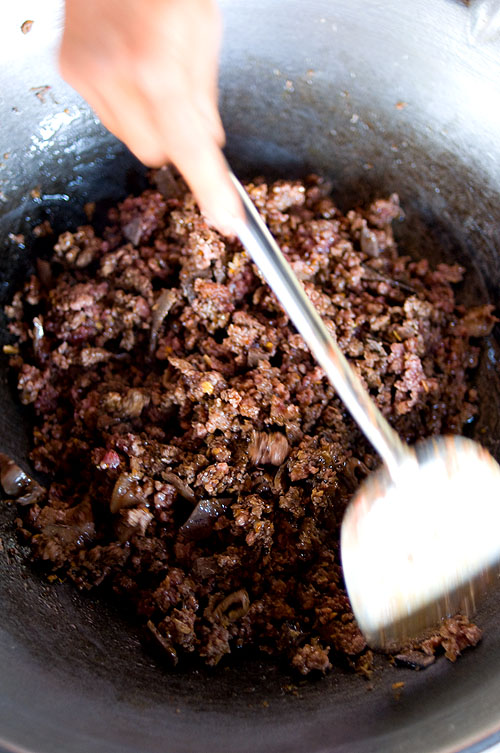 Fans of Thai food in the west are likely familiar with laap (or larb or laab), a minced meat ‘salad’ tart with lime juice and fragrant from the addition of khao khua, roasted and ground sticky rice. Fewer are likely familiar with the northern version of the dish of the same name, which contains neither khao khua nor lime juice, and instead gains its unique flavour from a mixture of dried spices specific to northern Thailand.
Fans of Thai food in the west are likely familiar with laap (or larb or laab), a minced meat ‘salad’ tart with lime juice and fragrant from the addition of khao khua, roasted and ground sticky rice. Fewer are likely familiar with the northern version of the dish of the same name, which contains neither khao khua nor lime juice, and instead gains its unique flavour from a mixture of dried spices specific to northern Thailand.
Laap mueang (mueang is a word used to describe anything northern) is one of my favourite Thai dishes. I've mentioned it a few times previously, but haven't really blogged about it in a general sense. So in this, the first of three blogs about the northern-style laap, I'm going to share general description of how it's made and the different varieties of it that exist. Because the spice mixture is such a crucial part of the dish, I'm hoping to follow this with a post about the delicious nam phrik laap (the spice mixture) made by a community group in Pha Bong, about 10km south of Mae Hong Son. And finally I'll follow that up with a recommendation for a decent laap restaurant here in Mae Hong Son.
If, after all this, you’re tempted to make laap khua, the northern-style ‘fried’ laap, I'd suggest combining the information provided in these blogs with this recipe provided the bloggers at EatingAsia, which appears to be a good approximation of the dish for those outside of northern Thailand without access to the more obscure ingredients.
I was able to watch Paa Add makes three types of laap while she was preparing food for her stall a couple days ago.

For all varieties of laap Paa Add begins with a variety of fresh pork and beef offal: liver, heart, tripe, intestine (both large and small), skin, fat and other unidentifiable (at least for me) bits. She boils them until tender and slices them thinly:
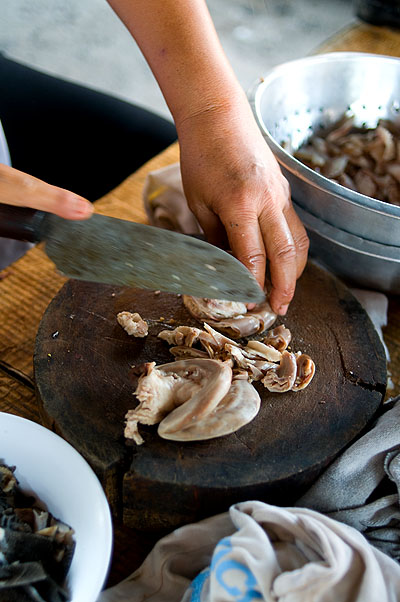
For the raw pork laap she takes a generous amount of fresh blood and liquefies it in a food processor. The impossibly red liquid is poured into a basin that already has some dried chili powder, salt, MSG, sugar and the laap spice mixture:
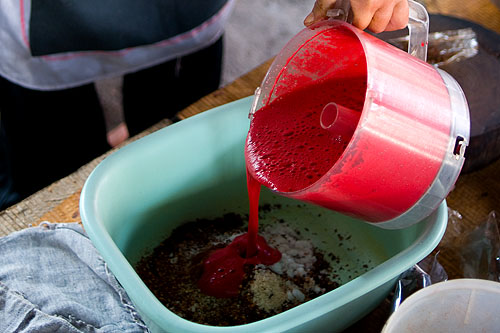
The ingredients are mixed with a spoon and raw minced pork is added. This is stirred again, checked for seasoning (after tasting the back of the spoon Paa Add added additional MSG, dried chili powder and some water), and the boiled pork offal is added. The laap is done at this point, and only requires a garnish of a mixture of minced coriander, sawtooth coriander (phak chee farang), green onions and mint, and of course, a fat basket of sticky rice to accompany it.
The process for making raw beef laap is nearly identical, except the ingredients, from the offal to the blood, are all beef-based, and a slightly bitter bile, known as phia, is added to the mixture:
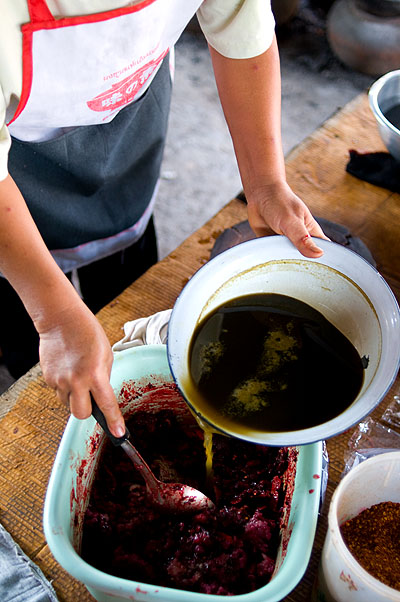
This type of laap is known in northern Thailand as laap khom, 'bitter' laap, because of the dominating flavour imparted by this ingredient.
The process to make make the more user-friendly laap khua, ‘fried’ pork laap, is initially at least, quite similar to the above. Paa Add combined some boiled pork offal, raw minced pork and a tiny amount of blood.
Into a large wok over hot coals she poured a very generous amount of cooking oil and added minced garlic, peels and all. She deep-fried the garlic until fragrant and ‘yellow’ in her words, before adding the pork mixture. This was followed by a generous amount of dried chili powder, MSG, salt, and the prepared laap spice mixture:
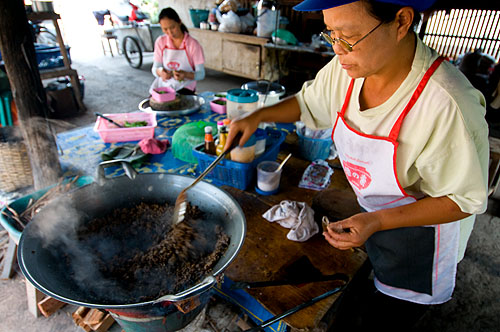
It took a good few minutes of cooking and stirring before the meat was thoroughly cooked and fragrant. She let me taste it at this point and the laap was intensely rich and spicy, and had the oily consistency associated with this version of the dish. Garnished and served with sticky rice and bitter herbs, it's among the most satisfying dishes in this part of the world.











